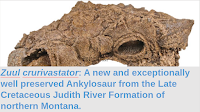The osteoderm, given the catalogue number GG 504, was discovered in several pieces by Jörg Ansorge in 2017, and subsequently prepared by him. The internal structure of the bone examined by micro-computed tomography at the Department of Cytology and Evolutionary Biology at the University of Greifswald.
The specimen comprises five separate fragments, which can be assembled to form a single piece with a maximum dimension of 15.5 cm. From the overall shape of this piece, Schade and Ansorge calculate that it represents about 75% of the original bone. Distinct striations can be seen on both surfaces of the specimen, appearing wrinkled under a light microscope, though these are rougher and more irregular on the more convex side. The osteoderm is thickest in the middle of what Schade and Ansorge assess to be its forward edge, where it is about 2 cm thick, tapering to the rear and either side. Both sides of the bone are convex, although one more than the other, with the specimen being slightly bent and the more convex side forming the inner part of the bend. The osteoderm appears to have originally been sub-parallel along much of its length, tapering towards the rear.
The bulk of the osteoderm appears to be made up of Haversian bone (bone made up of a series of parallel tubes, which in life would have held blood vessels), surrounded by a thin, laminated cortex. These laminae are separated by layers of aragonite in places, and appear to show lines of arrested growth.
Specimen GG 504 resembles a previously described specimen, GG 85/1 23, which has been assigned to Emausaurus, an early diverging Thyreophoran Dinosaur (that is to say, an early Thyreophoran Dinosaur that cannot be confidently assigned to either of the main Thyreophoran groups, the Stegosaurs and Ankylosaurs, and which presumably lived before those groups diverged), and which was also recovered from the Grimmen Clay Pit. However, GG 504 is significantly larger than GG 85/1 23 (15.5 cm vs 4.5 cm), and GG85/1 23 is the largest known osteoderm associated with Emausaurus. Furthermore, GG 85/1 23 has a rougher, more vascularised base than GG 504, and a less symmetrical shape.
GG 504 also shows some resemblances to osteoderms associated with Scutellosaurus lawleri, another early diverging Thyreophoran from the Early Jurassic of Arizona, although again it is significantly larger than any osteoderm associated with this species (Scutellosaurus lawleri is only thought to have reached about 120 cm in total length).
See also...


Online courses in Palaeontology.
Follow Sciency Thoughts on Facebook.
Follow Sciency Thoughts on Twitter.







